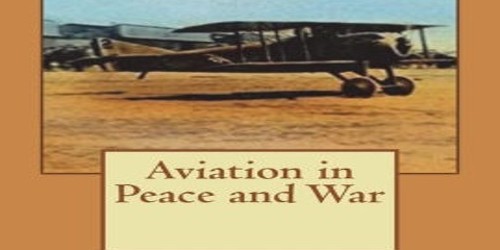Aviation in Peace and War – Book Review
This popular classic work by Sir Sykes is in the English language, and may not include graphics or images from the original edition. This fantastic book contains a wealth of information on the evolution of flying, and it is highly recommended for those with an interest in the subject. The title of this topic suggests a series of contrasts, perhaps between rocket-firing Hunter and the weekend pilot’s Chipmunk, or the Bomber photographing enemy installations from 30,000 feet and the Comet or Boeing long-distance jet airliner. yet the two are inextricably merged; the development of one has always depended on that of the other. Out of the hostile uses of the jet-engine, invented by the Englishman Sir Frank Whittle during the last war, has com the peaceful use of the jet transport and passenger plane.
Man has always longed to fly like the birds and in the 20th Century, his dream has come true. It is said that Michaelangelo invented a quite the practicable heavier-than-air flying machine which, had he had aluminum to play with instead of the iron, would have worked. Ballooning was quite common-place well before 1900, particularly in France; so were ‘gliders’ of a sort, which sometimes amounted to ‘wings’ of bamboo and cloth which served to carry a man a few yards off the ground in a high wind. But true aviation, that is powered ‘heavier-than-air’ flying, only came about with the development of the petrol engine which, by about 1896, had brought about the prototype motorcar. Primitive aircraft had come into being on both sides of the Atlantic by 1900; Orville and Wilbur Wright built a powered plane a Kitty Hawk which flew for 3 1/2 seconds and traveled 105 feet. Later Bleriot, a Frenchman made history by flying 22 miles across the English Channel in a biplane. Between 1900 and 1914 several countries had made serviceable aircraft, mostly biplanes, gradually overcoming design problems, increasing wing-lift and power, reducing weight and thereby increasing fuel capacity, ironing out facets of maneuverability, and adding both height and speed potential. But pre-1941 aircraft were scarcely more than toys; nobody trusted them for travel purposes, the range was severely limited, and as freighters, they were not worth considering.
It was the outbreak of the First World War which gave a tremendous impetus of flying, and the potential of aircraft as weapons were swiftly realized. Money was spent by both sides on design-research and eventually, primitive warplanes were mass-produced by both sides. At first, the Handley-Pages and the Camels were visualized only as aerial observation-posts on the Western Front, but this swiftly led to overhead engagements, the pilots shooting it out with revolvers. Later, machine-guns, with a limited are of fire, were fitted, but a great advance came with the Synchronized Machine-gun, capable of firing through a propeller. These aircraft certainly had nuisance value, as had the dirigibles with their bombs, such as the German Zeppelins, and the early bombers used in the open country against concentrated forces, as in T.E. Lawrence’s desert campaign, but nobody could portend they were crucial. it is an irony, however, that their development laid the foundation for the ‘growing-up’ of Civil Aviation between the wars.
In most countries, their period was a sad story of governmental indifference and brave efforts by individuals to put flying ‘on the map’. The whole world applauded Charles Lindbergh who flew the Atlantic in 1926, and Amy Johnson, who flew alone in a series of short ‘hops’ to Australia. But flying really grew up in the ’30s when metal monoplanes of long-range and high-reliability standards were produced. The early passenger and freight lines were produced. The early passenger and freight lines were established; seaplanes were invented — even ski-planes for polar exploration. But Hitler had realized the war-potential of the aircraft, and his early panzer-attacks in Europe and Egypt move on with ruthless efficiency, supported by the high-level saturation bomber and the Stuka dive-bomber. Britain and America had to catch up fast. Hurricanes and Spitfires saved Britain from invasion, and the American Boeings and British Whitleys and Wellingtons virtually destroyed the Ruhr towns in preparation for the Second Front. Airpower was crucial in the allied victory in the East as well as the West. Hiroshima and Nagasaki reversed Pearl Harbor and Singapore.
This vintage book contains a fascinating history of aviation, being a detailed exploration of its development and utility in peace and in war. In 1904, Sykes’s (the author) interest in aviation was first demonstrated when he obtained his ballooning certificate whilst being attached to the Balloon Section of the Royal Engineers.
Information Source:
















